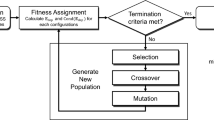Abstract
At the Institute of Nuclear Physics, a nine-pole hybrid wiggler is developed and successfully installed on the VEPP-4 accelerator complex. The nine poles of the wiggler are electromagnets with iron cores. To achieve the largest field, permanent magnets with a residual induction of 1.2 T are installed between the wiggler poles. Such a combination of electromagnets and permanent magnets made it possible to achieve a maximum magnetic induction of 1.9 T, with an interpolar gap of 30 mm. Currently, at the Siberian Center of Synchrotron and Terahertz Radiation, several research methods using the “hard” X-ray range (50–250 keV) based on radiation from a nine-pole wiggler are being certified. For example, using this radiation, the X‑ray imaging of fast processes, X-ray computed tomography, X-ray fluorescence analysis, and X-ray diffraction studies are carried out. A brief review of these studies is presented.





Similar content being viewed by others
REFERENCES
E. B. Levichev, Phys. Part. Nucl. Lett. 13, 883 (2016).
V. V. Anashin, V. M. Aulchenko, E. M. Baldin, et al., Phys. Part. Nuclei 44, 657 (2013).
A. N. Aleshaev, P. I. Zubkov, G. N. Kulipanov, et al., Fiz. Goreniya Vzryva, 37 (5), 104 (2001).
H. Motz, W. Thon, and R. N. Whiterhurst, J. Appl. Phys. 7, 826 (1953). https://doi.org/10.1063/1.1721389
P. Vobly, G. Baranov, E. Levichev, et al., IEEE Trans. Appl. Supercond. 28 (3), 4101403 (2018). https://doi.org/10.1109/TASC.2018.2791921
P. A. Piminov, G. N. Baranov, A. V. Bogomyagkov, et al., Phys. Procedia 84, 26 (2016).
Comsol Application. www.comsol.ru
M. Grotzer, E. Schultke, E. Brauer-Krisch, et al., Phys. Med 31 (6), 564 (2015).
K. E. Kuper, E. L. Zavjalov, I. A. Razumov, et al., Phys. Procedia 84, 252 (2016).
A. S. Arakcheev, A. N. Shmakov, M. R. Sharafutdinov, et al., J. Struct. Chem. 57, 1314 (2016). https://doi.org/10.15372/JSC20160703
A. A. Legkodymov, K. E. Kuper, V. P. Naz’mov, et al., Bull. Russ. Acad. Sci.: Phys. 79, 103 (2015). https://doi.org/10.3103/S1062873815010207
K. Tsuji, J. Injuk, and R. van Grieken, X-Ray Spectrometry: Recent Technological Advances (John Wiley &Sons, Chichester, 2004).
Funding
The study was supported by a grant from the Russian Science Foundation (project no. 14-50-00080) using the unique research facility “VEPP-4–VEPP-2000 Complex” with financial support from the Ministry of Education and Science of the Russian Federation (unique project identifier RFMEFI61917X0008).
Author information
Authors and Affiliations
Corresponding author
Rights and permissions
About this article
Cite this article
Baranov, G.H., Cooper, K.E., Piminov, P.A. et al. Hybrid Nine-Pole Wiggler as a Source of “Hard” X-ray Radiation at the VEPP-4 Accelerator Complex. J. Surf. Investig. 14, 1290–1293 (2020). https://doi.org/10.1134/S1027451020060269
Received:
Revised:
Accepted:
Published:
Issue Date:
DOI: https://doi.org/10.1134/S1027451020060269



